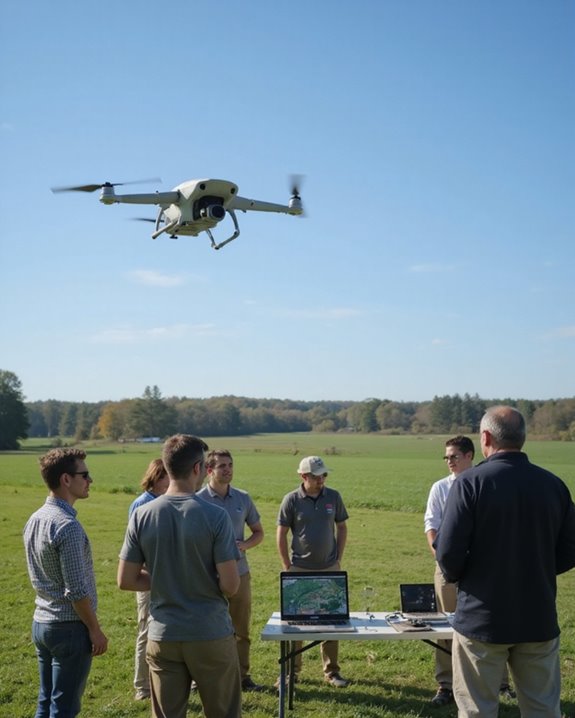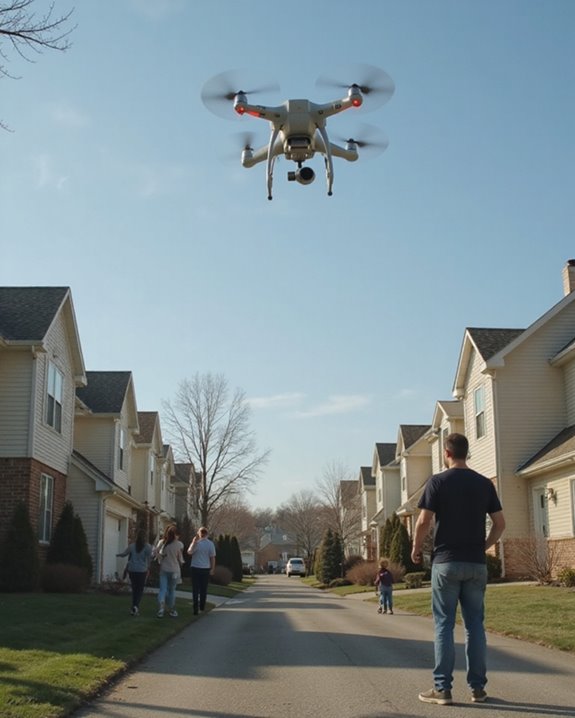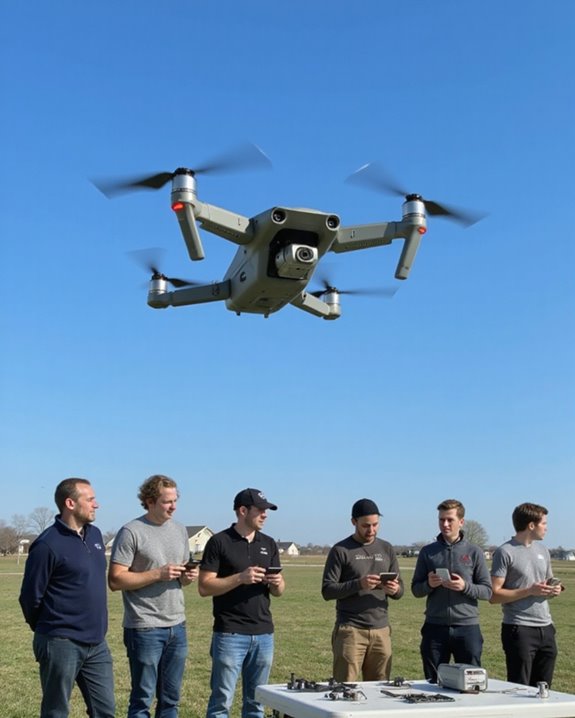Drones are like flying robots, zooming over fields to spray crops, delivering medicine to far-off hospitals, chasing suspects for police, or snapping jaw-dropping photos for movies and real estate listings. Farmers use them to save water and fertilizer, militaries fly them for stealthy operations, and even firefighters deploy drones in disasters, capturing real-time rescue images. With high-tech GPS and cameras, these buzzing helpers are everywhere—making life easier and maybe, just maybe, way cooler! Stick around to see what else drones can do next.
Key Takeaways
- Drones are used in agriculture for precision spraying, crop monitoring, and efficient farm management across diverse crop types.
- Military and law enforcement utilize drones for surveillance, reconnaissance, search and rescue, and coordinated tactical operations.
- Drones provide high-quality aerial photography and videography for real estate, filmmaking, and event coverage.
- Delivery and logistics sectors employ drones to transport packages, medical supplies, and aid to both urban and remote locations.
- Advanced drones leverage AI, GPS, and swarm technology to optimize performance in emergency response, inspection, and large-scale operations.
Drones in Modern Agriculture
Imagine a field buzzing—not with bees, but with drones! Today, agriculture is getting a high-tech makeover, thanks to Drone Education and the rise of livestock monitoring. Farmers use drones for crop spraying, field mapping, and even checking on cows from afar—so much easier than chasing runaway sheep! With over 400,000 DJI agricultural drones working across 100 countries, these flying helpers cover 500 million hectares, helping grow over 300 crop types. They save water by precision spraying, reduce fertilizer waste, and cut down on carbon emissions—nearly like planting a billion trees! As more countries simplify regulations and train new pilots, including young people and women, Drone Education is now a must-have skill for modern farming. Who knew the future of agriculture would fly? Large-scale agricultural drones with 30-liter tanks cover 7 hectares per hour via GPS-guided precision spraying systems.
Military Applications of Drone Technology

While drones are busy helping farmers grow more food, they’re also making headlines in another field—the military! Military drones are not just flying robots; they’re high-tech tools for Stealth Operations, spying, and even delivering supplies. North America, especially the U.S., leads the way, investing billions in these futuristic machines. Thanks to artificial intelligence, drones can now perform tasks once reserved for humans, from Autonomous Warfare to complex surveillance missions. Swarm technology lets many drones work together, almost like a robotic flock of birds! The global market for military drones is booming, with projected growth skyrocketing to $56.69 billion by 2033. Still, not everyone’s on board: younger people and certain job sectors are less enthusiastic about using drones for military purposes. Fascinating, right? The RQ-11 Raven UAV is a prime example, offering exceptional portability for battlefield reconnaissance missions.
Enhancing Law Enforcement With Drones
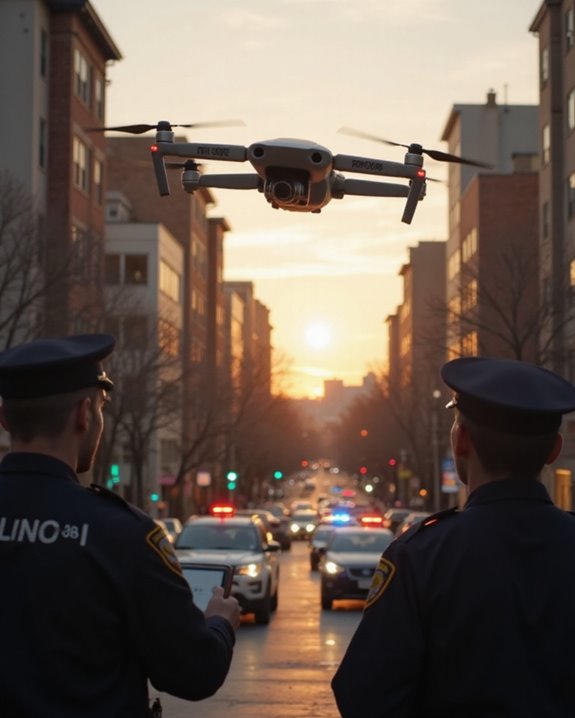
In recent years, drones have become a game-changer for law enforcement, soaring far beyond the days of simple patrol cars and walkie-talkies! Today, more than 1,400 U.S. communities rely on drones for operations like search and rescue, disaster response, and suspect searches—imagine a flying partner with high-tech eyes. These flying gadgets are also a big help with evidence gathering, using high-resolution cameras and real-time data to document crime scenes or track suspects. Of course, all this comes with a price tag, as police agencies spent over $646,000 on drones in 2022 alone. But it’s not just about gadgets; surveillance ethics remain vital. Departments must balance safety with privacy concerns, ensuring drone use complies with legal and ethical standards to build public trust. Many modern drones, like those equipped with 3-axis gimbals, provide stable and clear footage crucial for accurate surveillance.
Revolutionizing Photography and Videography
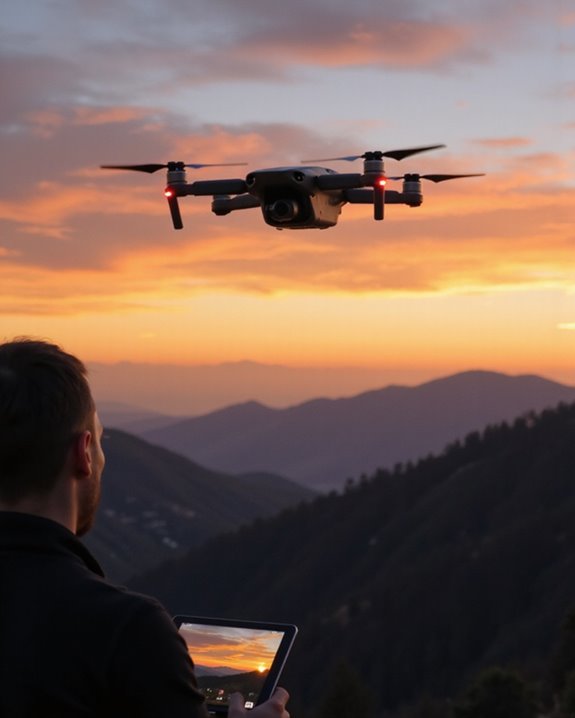
Aerial artistry has soared to new heights thanks to drones, opening up a stunning world of photography and videography that was once reserved for helicopters and blockbuster budgets. Today, drones with high-definition cameras capture Artistic Imaging that wows audiences—think breathtaking real estate tours or sweeping movie landscapes. Real estate agents love using drones for dramatic home presentations, with about 82% relying on these flying marvels to showcase properties. In film and sports, directors use Cinematic Techniques made possible by drones, such as smooth aerial tracking shots and dizzying spins! Enhanced by AI and real-time analytics, drone videography keeps getting smarter and more creative. Whether it’s a wedding, a soccer match, or capturing a mountain sunrise, drones make every shot feel like movie magic.
Innovations in Delivery and Logistics
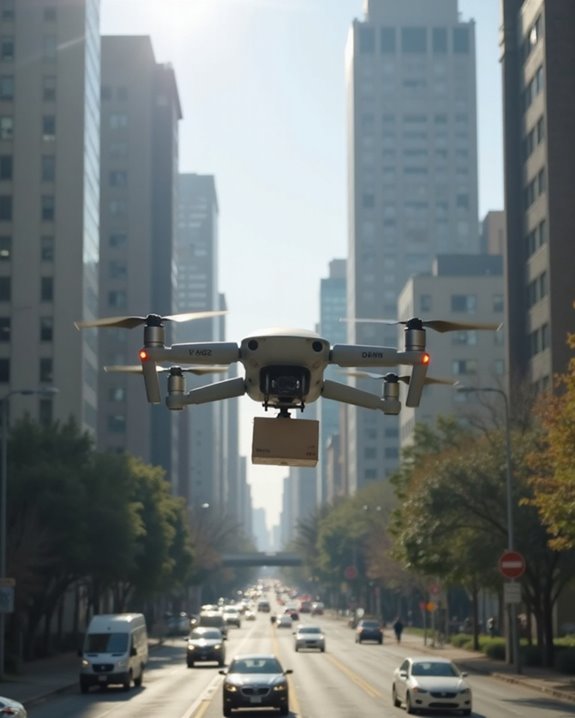
Just when you thought drones couldn’t get any cooler than capturing Hollywood-worthy videos, get ready for their next big act: shaking up the delivery and logistics world! Drones are powering ahead with Autonomous Delivery, making it possible for packages and even medical supplies to fly straight to your doorstep or hospital rooftop. With advancements in AI, GPS, and battery life, drones are now pros at Logistics Optimization—zipping over traffic jams to reach even the trickiest locations. Major players like Alphabet and Zipline are leading the charge, while new startups and classic companies alike race to innovate. Regulatory support is growing, especially in North America and Europe, helping drones break into urban and remote areas. The future? Fast, accurate, and almost sci-fi-like delivery!
Disaster Management and Rescue Operations
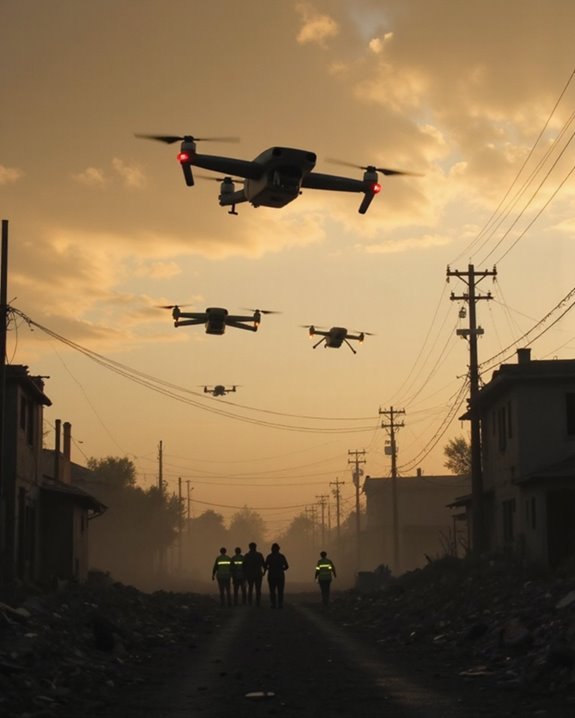
When disaster strikes—whether it’s a raging flood, an earthquake, or a landslide—drones swoop in as modern-day superheroes, ready to save the day! With Flood Response, drones zip over swollen rivers, capturing real-time images of water levels and damaged bridges, giving rescue teams the upper hand. In Earthquake Aid, they navigate dangerous rubble, quickly spotting survivors and evaluating structural damage, all without putting humans in harm’s way. Drones can reach places where people or vehicles can’t, like isolated villages or blocked mountain paths. They’re not just fast—they’re cost-effective, too, helping save money while saving lives. High-tech sensors and detailed photos allow experts to plan recovery efforts and document progress, turning chaos into organized action, one buzzing flight at a time!
Emerging Trends and Future Potential of Drones
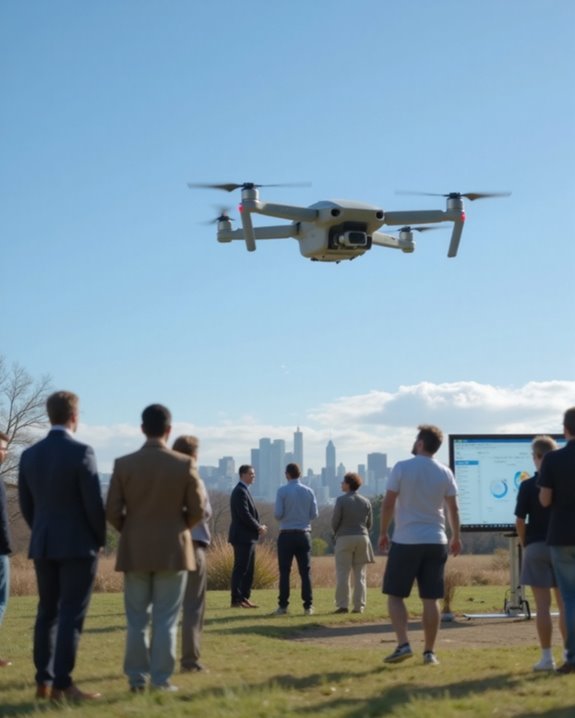
While drones already play the hero during disasters, their story is only getting more exciting as technology races ahead! Today’s drones are like superheroes with new gadgets—AI brains, advanced sensors, and even swappable payloads. Imagine entire Drone Swarms working together to inspect bridges, monitor wildlife, or help on farms, all while barely needing a break. In agriculture, drones are mapping fields, spotting sick crops, and using AI to predict harvests—farmers everywhere are celebrating!
With low-light obstacle avoidance and precise navigation, these flying helpers are safer and smarter than ever. The drone Market Growth is soaring, expected to hit $57 billion by 2028. Companies are already offering custom drones for everything from construction surveys to public safety. Clearly, the sky’s the limit for drone innovation!
Frequently Asked Questions
What Are the Main Types of Drones Available for Personal Use?
The main types of drones available for personal use reflect Drone Evolution and Hobby Innovations: multi-rotor, fixed-wing, hybrid VTOL, nano, and small drones, each catering to recreational, photography, travel, educational, and racing applications for enthusiasts.
How Do Drones Maintain Stable Flight and Avoid Obstacles?
Drones harness sensor technology and flight algorithms with almost supernatural precision, using gyroscopes, accelerometers, and cameras to maintain stability. Proximity sensors and advanced algorithms enable real-time obstacle detection, allowing seamless navigation and safe flight in complex environments.
What Are the Legal Requirements for Flying a Drone Recreationally?
Legal requirements for flying a drone recreationally include Drone Registration for devices over 0.55 lbs, completion of Safety Training via the TRUST test, adherence to FAA safety guidelines, maintaining visual line of sight, and observing altitude and no-fly zone restrictions.
How Long Can Consumer Drones Typically Fly on a Single Battery Charge?
Typical consumer drones achieve 15 to 30 minutes of flight per battery charge, although battery upgrades and improved energy efficiency in premium models can extend durations to 45 minutes. Payload, weather, and flight style further influence total airborne time.
What Are the Privacy Concerns Associated With Drone Usage?
Privacy concerns associated with drone usage include unauthorized surveillance, potential invasion of personal spaces, and challenges to Surveillance Ethics. Data Security risks arise from unauthorized access or misuse of collected information, highlighting the need for updated privacy laws and robust safeguards.

